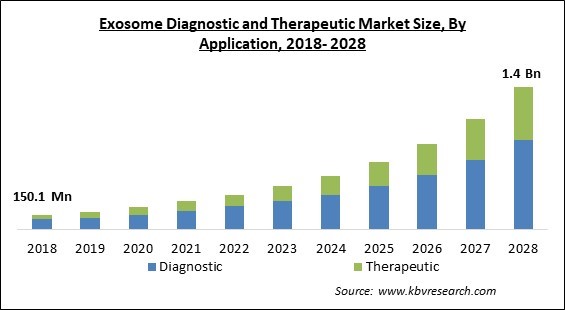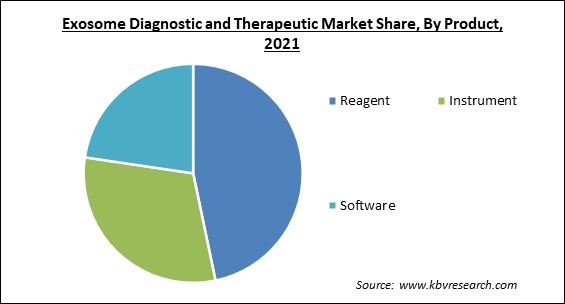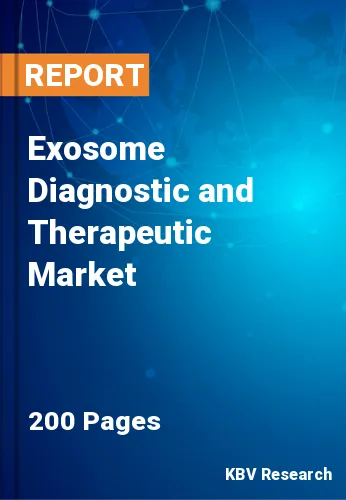The Global Exosome Diagnostic and Therapeutic Market size is expected to reach $1.4 billion by 2028, rising at a market growth of 26.5% CAGR during the forecast period.
An exosome is a membrane-bound vesicle produced by eukaryotic cells in their extracellular compartment. Immune responses, viral pathogenicity, pregnancy, cardiovascular disorders, central nervous system-related diseases, and cancer progression are all linked to exosomes. Exosomes effectively transfer biomolecules such as metabolites, proteins, and nucleic acids into target cells to affect their biological response. Exosomes are designed to carry a variety of therapeutic payloads, including short interfering ribonucleic acids (RNAs), antisense oligonucleotides, chemotherapeutic drugs, and immunological modulators, to specific targets. Exosome vesicle-based liquid biopsy has the potential to be employed in the diagnosis and prognosis of cancer and other illnesses in patients.
Increased usage of exosome therapy's multifunctional properties for chronic heart failure, Alzheimer's disease, Parkinson's disease, and cancer, including breast, liver, prostate, and lung cancer, is a key factor driving the research on exosomes. Aethlon Medical, a healthcare startup, also announced collaboration with the University of Pittsburgh on a National Institute of Health grant for the treatment of head and neck cancer in August 2020. Exosomes are nano-sized particles that are released in great quantities by cancer cells that contain a tumor's genetic and protein cargo, fueling cancer growth and suppressing the immune system.
The rising prevalence of cancer, technological breakthroughs in exosome isolation and analysis methods, and expanding sophisticated uses of exosomes are all factors driving market expansion. The increased demand for exosomes is directly related to the rising prevalence of cancer patients. According to the GLOBOCAN 2020 report, 19.29 million new cancer cases were diagnosed in 2020, with this number anticipated to climb over the next two decades. Further, the American Cancer Society predicted that 1,898,160 new instances of cancer would be identified in the United States in 2021, with 608,570 people dying from the disease in 2020.

The global COVID-19 pandemic wreaked havoc on people's health and the economy. It has influenced entire economies and enterprises, as well as individual careers and personal lives. The stress of maintaining income levels at pre-COVID levels has become the new normal as firms shift their focus away from development prospects and onto implementing exceptional steps to limit the detrimental impact of the COVID-19 pandemic. In the ongoing fight against COVID-19, pharmaceutical and healthcare corporations, governments, and the greater scientific community are all striving to quantify the virus's impact and deliver quick, precise therapies.
Exosome diagnostic and therapeutic markets are growing in response to the rising prevalence of cardiovascular diseases (CVDs). This is due to the advancement of technologically advanced devices that have a long lifespan. Unhealthy eating habits, tobacco consumption, and lack of physical activity are only a few of the key causes of cardiovascular disease, which increase blood pressure and blood glucose levels, resulting in overweight and obesity. According to the World Health Organization, heart attacks and strokes account for four out of every five cardiovascular fatalities, with one-third of these deaths occurring in adults under the age of 70.
An immune system imbalance could cause the inflammatory pathway to overreact. Inflammation is triggered by tissue injury or pathogen detection. The probability of malignant cell transformation has been linked to chronic inflammation. If cancer progresses, many immune system modulations are necessary, including apoptosis, proliferation, and angiogenesis. The accumulation of inflammatory mediators (Stat3, IL-6, and TNF-alpha) leads to immunosuppression and cancer growth. Exosomes can play a role in the control and modulation of immunological players by blocking or encouraging their activity.
Affordability concerns related to high diagnostic costs and a high incidence of cancer in low-income groups are two reasons that are expected to slow the expansion of the exosome diagnostic and therapeutic market. Lack of validation standardization for exosome isolation and inadequate insurance coverage of high-cost tests are also expected to stymie market expansion. While exosomes' diagnostic potential has been widely recognized and investigated, such as in brain cancer, the use of exosomes for diagnostics and biomarker discovery in central nervous system (CNS) illnesses is still in its early stages of discovery and development.

Based on Application, the market is segmented into Diagnostic and Therapeutic. The diagnostic segment acquired the largest revenue share in the exosome diagnostic and therapeutic market in 2021. This is due to a rise in chronic disease incidence and a surge in demand for early detection. Another aspect driving this market's demand is the emergence of an explicit approach to studying exosome-specific proteins. Moreover, the rising demand for additional development and research activities, which is further encouraged by government organization policies around the world, is one of the major factors driving this market's demand upward. Other key factors are the increasing adoption of exosomes based on CTC and CTDNA.
Based on Product, the market is segmented into Reagent, Instrument, and Software. The instrument segment procured a substantial revenue share in the exosome diagnostic and therapeutic market in 2021. Instruments are essentially used to extract and analyze exosome samples. The largest market share is due to developments in R&D activities in the healthcare industry and an expansion in the number of important manufacturers. For instance, the Thermo Fisher Scientific KingFisher Apex Purification System, a high-throughput sample purification equipment designed for scientists that need to automate the extraction of DNA, RNA, proteins, and cells from a variety of sample types, was released in April 2021.
Based on End User, the market is segmented into Cancer Institute, Hospital, Diagnostic Center, and Others. The cancer institute segment acquired the largest revenue share in the exosome diagnostic and therapeutic market in 2021. This is attributable to an increase in cancer incidence, an increase in the number of hospitals, and a spike in government measures to expand healthcare infrastructure.
| Report Attribute | Details |
|---|---|
| Market size value in 2021 | USD 283.2 Million |
| Market size forecast in 2028 | USD 1.4 Billion |
| Base Year | 2021 |
| Historical Period | 2018 to 2020 |
| Forecast Period | 2022 to 2028 |
| Revenue Growth Rate | CAGR of 26.5% from 2022 to 2028 |
| Number of Pages | 200 |
| Number of Tables | 349 |
| Report coverage | Market Trends, Revenue Estimation and Forecast, Segmentation Analysis, Regional and Country Breakdown, Companies Strategic Developments, Company Profiling |
| Segments covered | Product, Application, End User, Region |
| Country scope | US, Canada, Mexico, Germany, UK, France, Russia, Spain, Italy, China, Japan, India, South Korea, Singapore, Malaysia, Brazil, Argentina, UAE, Saudi Arabia, South Africa, Nigeria |
| Growth Drivers |
|
| Restraints |
|
Based on Regions, the market is segmented into North America, Europe, Asia Pacific, and Latin America, Middle East & Africa. North America acquired the largest revenue share in the exosome diagnostic and therapeutic market in 2021. This is due to a growth in the incidence of chronic diseases, an increase in the number of exosome therapies product launches, an increase in the presence of important companies, and the expansion of research and development activities in the pharmaceutical and biopharmaceutical sectors in the region. The United States government spends trillions of dollars on improving the healthcare infrastructure and accessibility each year. This has resulted in the growth of the exosome diagnostic and therapeutic market in the country.
Free Valuable Insights: Global Exosome Diagnostic and Therapeutic Market size to reach USD 1.4 Billion by 2028
The market research report covers the analysis of key stake holders of the market. Key companies profiled in the report include Bio-Techne Corporation, Qiagen N.V., Thermo Fisher Scientific, Inc., Aethlon Medical, Inc., Capricor Therapeutics, Inc., Malvern Panalytical Ltd., NanoSomix, Inc., System Biosciences, LLC, and NX Pharmagen, Inc.
By Application
By Product
By End User
By Geography
The global exosome diagnostic and therapeutic market size is expected to reach $1.4 billion by 2028.
Rising Incidence of Cardiovascular Diseases are driving the market in coming years, however, high cost of diagnosis and limited use of exosomes in diagnosis of CNS diseases growth of the market.
Bio-Techne Corporation, Qiagen N.V., Thermo Fisher Scientific, Inc., Aethlon Medical, Inc., Capricor Therapeutics, Inc., Malvern Panalytical Ltd., NanoSomix, Inc., System Biosciences, LLC, and NX Pharmagen, Inc.
The expected CAGR of the exosome diagnostic and therapeutic market is 26.5% from 2022 to 2028.
The Reagent segment acquired maximum revenue share in the Global Exosome Diagnostic and Therapeutic Market by Product in 2021, thereby, achieving a market value of $655.1 million by 2028.
The North America is the fastest growing region in the Global Exosome Diagnostic and Therapeutic Market by Region in 2021, and would continue to be a dominant market till 2028.
Our team of dedicated experts can provide you with attractive expansion opportunities for your business.

